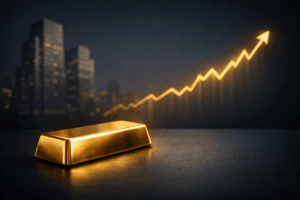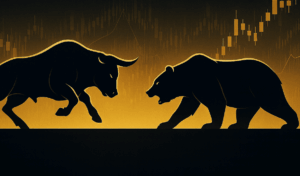The silver market is flashing signals we haven’t seen in decades. In his latest video, Mike Maloney explains why silver’s chart pattern — the classic “cup and handle” — has broken out on major time frames, and why that could point to three-digit silver prices in the years ahead. Let’s unpack the key highlights from Mike’s update.
The Cup-and-Handle Breakout
On daily, weekly, and especially quarterly charts, silver has now completed a cup-and-handle pattern that technical analysts have been watching for years. Historically, this formation precedes major upside moves. Mike notes that silver hasn’t closed above $40 on a quarterly basis since 1980 — but that barrier has now been breached, setting the stage for significantly higher prices.
Technical breakouts at this scale don’t happen often. With silver doubling in just the past two years, the momentum could accelerate into a move toward triple digits.
Physical Buyers vs. Paper Sellers
Mike highlights a key dynamic: physical buyers aren’t deterred by dips — they’re waiting for them. Meanwhile, sellers of paper silver contracts face a risk they can’t escape: you can’t print physical metal. This growing divide between paper and physical markets has the potential to squeeze those who bet against silver.
When demand for real ounces collides with leveraged paper supply, the imbalance can trigger sharp price moves.
UBS and the Big Banks Flip
One of the most striking developments is UBS — a major global investment bank — raising its silver forecast and openly admitting that all-time highs are possible. Mike points out that big banks rarely make such bullish calls until after they’ve already shifted their own positions from short to long. In other words, they may now stand to profit from silver’s rise instead of suppressing it.
Institutional money moving into silver can supercharge rallies, especially when combined with retail and physical demand.
East vs. West: The “Silver Milkshake” Theory
Mike shares data showing that silver is priced higher in China than in Western markets — by as much as 3.5% on the same day. This arbitrage is causing silver to flow from West to East, echoing the “dollar milkshake theory” in currency markets. Right now, it’s Eastern demand — led by China — that is driving both gold and silver higher.
Persistent price premiums in Asia signal strong demand and shift the center of gravity for silver pricing away from the West.
A Bubble Bigger Than 1980?
Looking at long-term charts, Mike argues that today’s setup dwarfs the 1980 silver spike. Back then, the economy was imbalanced — but nothing like the vulnerabilities we see today. With debt levels, monetary expansion, and global uncertainty far worse, the next silver rally could exceed anything in living memory.
Silver has already doubled in two years, and if history rhymes, we may only be in the early innings of a much larger move.
The Big Picture on Silver’s Next Phase
Silver’s technical breakout, coupled with global demand shifts and institutional recognition, suggests the metal may be entering a powerful new phase. Whether you’re a seasoned stacker or just exploring precious metals, this is a moment worth paying close attention to.
People Also Ask
What does the “cup and handle” breakout in silver mean?
The cup-and-handle pattern is a technical chart formation that often signals major upward moves. Silver has now broken out on quarterly and yearly charts, which suggests the potential for a sustained rally — possibly toward triple-digit prices.
Why are physical silver buyers important to the market?
Physical buyers tend to buy during dips, unlike paper sellers who trade contracts. Because you can’t print physical silver, strong physical demand can tighten supply and push prices higher when it collides with paper market selling.
Why does UBS raising its silver forecast matter?
UBS, a major global bank, recently projected silver could reach new all-time highs. Large institutions usually only make bullish calls once they’ve shifted their own positions, meaning they may now be aligned to benefit from silver’s rise rather than suppress it.
What is the “Silver Milkshake” theory?
Similar to the “dollar milkshake theory,” it refers to price differences between East and West. When silver is priced higher in China than in Western markets, metal flows eastward. This trend shows strong Asian demand is increasingly setting global silver prices.
Could silver’s next rally be bigger than the 1980 spike?
Mike Maloney argues yes. In 1980, silver spiked amid economic stress, but today’s imbalances — from debt to monetary expansion — are far worse. Combined with technical breakouts and global demand, the setup could exceed the 1980 rally.
Get Gold & Silver Insights Direct to Your Inbox
Join thousands of smart investors who receive expert analysis, market updates, and exclusive deals every week.








